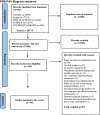Community-level interventions for mitigating the risk of waterborne diarrheal diseases: a systematic review
- PMID: 35436979
- PMCID: PMC9016942
- DOI: 10.1186/s13643-022-01947-y
Community-level interventions for mitigating the risk of waterborne diarrheal diseases: a systematic review
Abstract
Background: Waterborne diarrhea diseases are among the leading causes of morbidity and mortality globally. These diseases can be mitigated by implementing various interventions. We reviewed the literature to identify available interventions to mitigate the risk of waterborne diarrheal diseases.
Methods: We conducted a systematic database review of CINAHL (Cumulative Index to Nursing and Allied Health Literature), PubMed, Web of Science Core Collection, Cochrane library, Scopus, African Index Medicus (AIM), and LILACS (Latin American and Caribbean Health Sciences Literature). Our search was limited to articles published between 2009 and 2020. We conducted the review using the Preferred Reporting Items for Systematic Reviews and Meta-Analyses (PRISMA) statement checklist. The identified studies were qualitatively synthesized.
Results: Our initial search returned 28 773 articles of which 56 studies met the inclusion criteria. The included studies reported interventions, including vaccines for rotavirus disease (monovalent, pentavalent, and Lanzhou lamb vaccine); enhanced water filtration for preventing cryptosporidiosis, Vi polysaccharide for typhoid; cholera 2-dose vaccines, water supply, water treatment and safe storage, household disinfection, and hygiene promotion for controlling cholera outbreaks.
Conclusion: We retrieved few studies on interventions against waterborne diarrheal diseases in low-income countries. Interventions must be specific to each type of waterborne diarrheal disease to be effective. Stakeholders must ensure collaboration in providing and implementing multiple interventions for the best outcomes.
Systematic review registration: PROSPERO CRD42020190411 .
© 2022. The Author(s).
Conflict of interest statement
The authors declare no competing interests.
Figures
References
-
- Percival SL, Yates MV, Williams DW, Chalmers R, Gray NF. Microbiology of waterborne diseases: microbiological aspects and risks. 2. Amsterdam: Elsevier/Academic Press; 2014.
-
- Woodall CJ. Waterborne diseases - what are the primary killers? Desalination. 2009;248(1-3):616–621. doi: 10.1016/j.desal.2008.05.110. - DOI
Publication types
MeSH terms
Substances
LinkOut - more resources
Full Text Sources
Medical
Miscellaneous


